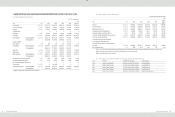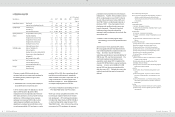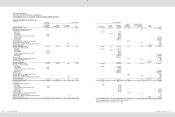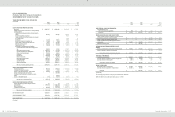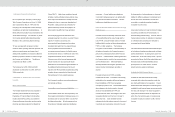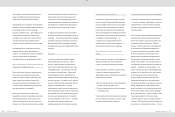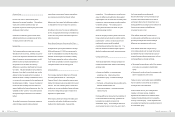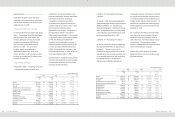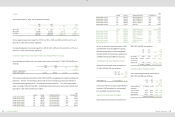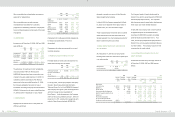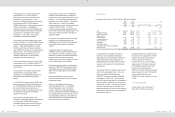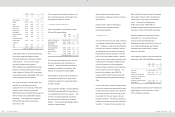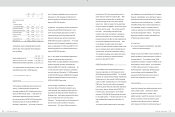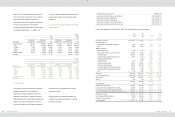HTC 2008 Annual Report Download - page 80
Download and view the complete annual report
Please find page 80 of the 2008 HTC annual report below. You can navigate through the pages in the report by either clicking on the pages listed below, or by using the keyword search tool below to find specific information within the annual report.
Financial Information
| 25
24 |
2008 Annual Report
Pension Plan
Pension cost under a defined benefit plan is
determined by actuarial valuations. Contributions
made under a defined contribution plan are
recognized as pension cost during the year in which
employees render services.
Curtailment or settlement gains or losses of the
defined benefit plan are recognized as part of the
net yearic pension cost for the year.
Income Tax
The Company applies intra-year and inter-year
allocations for its income tax, whereby (1) a portion
of income tax expense is allocated to the cumulative
effect of changes in accounting principles; and (2)
deferred income tax assets and liabilities are
recognized for the tax effects of temporary
differences, unused loss carryforward and unused
tax credits. Valuation allowances are provided to
the extent, if any, that it is more likely than not that
deferred income tax assets will not be realized. A
deferred tax asset or liability is classified as current
or noncurrent in accordance with the classification of
its related asset or liability. However, if a deferred
income tax asset or liability does not relate to an
asset or liability in the financial statements, then it is
classified as either current or noncurrent based on
the expected length of time before it is realized or
settled.
Tax credits for purchases of machinery, equipment
and technology, research and development
expenditures, and personnel training expenditures
are recognized using the flow-through method.
Adjustments of prior years’ tax liabilities are added to
or deducted from the current year’s tax provision.
According to the Income Tax Law, an additional tax
at 10% of unappropriated earnings is provided for as
income tax in the year the stockholders approve to
retain the earnings.
Stock-Based Employee Compensation Plans
Employee stock options granted between January 1,
2004 and December 31, 2007 were accounted for
under the interpretations issued by the Accounting
Research and Development Foundation (“ARDF”).
The Company adopted the intrinsic value method,
under which compensation cost was recognized on
a straight-line basis over the vesting period.
Treasury Stock
The Company adopted the Statement of Financial
Accounting Standards No. 30 - “Accounting for
Treasury Stocks,” which requires the treasury stock
held by the Company to be accounted for by the cost
method. The cost of treasury stock is shown as a
deduction to arrive at stockholders’ equity, while gain
or loss from selling treasury stock is treated as an
adjustment to capital surplus.
When treasury stocks are sold and the selling price
is above the book value, the difference should be
credited to the capital surplus - treasury stock
transactions. If the selling price is below the book
value, the difference should first be offset against
capital surplus from the same class of treasury stock
transactions, and any remainder should be debited
to retained earnings. The carrying value of
treasury stocks should be calculated using the
weighted-average method.
When the Company's treasury stock is retired, the
treasury stock account should be credited, and the
capital surplus - premium on stock account and
capital stock account should be debited
proportionately according to the share ratio. The
difference should be credited to capital surplus or
debited to capital surplus and/or retained earnings.
Foreign Currencies
The financial statements of foreign operations are
translated into New Taiwan dollars at the following
exchange rates:
a. Assets and liabilities - at exchange rates
prevailing on the balance sheet date;
b. Stockholders’ equity - at historical exchange
rates;
c. Dividends - at the exchange rate prevailing on the
dividend declaration date; and
d. Income and expenses - at average exchange
rates for the year.
Exchange differences arising from the translation of
the financial statements of foreign operations are
recognized as a separate component of
stockholders’ equity. Such exchange differences
are recognized as gain or loss in the year in which
the foreign operations are disposed of.
Nonderivative foreign-currency transactions are
recorded in New Taiwan dollars at the rates of
exchange in effect when the transactions occur.
Exchange differences arising from the settlement of
foreign-currency assets and liabilities are
recognized as gain or loss.
At the balance sheet date, foreign-currency
monetary assets and liabilities are revalued using
prevailing exchange rates and the exchange
differences are recognized in profit or loss.
At the balance sheet date, foreign-currency
nonmonetary assets (such as equity instruments)
and liabilities that are measured at fair value are
revalued using prevailing exchange rates, with the
exchange differences treated as follows:
a. Recognized in stockholders’ equity if the changes
in fair value are recognized in stockholders’
equity;
b. Recognized in profit and loss if the changes in fair
value is recognized in profit or loss.
Foreign-currency nonmonetary assets and liabilities
that are carried at cost continue to be stated at
exchange rates at the trade dates.
If the functional currency of an equity-method
investee is a foreign currency, translation
adjustments will result from the translation of the
investee’s financial statements into the reporting
currency of the Company. These adjustments are
accumulated and reported as a separate component
of stockholders’ equity.


